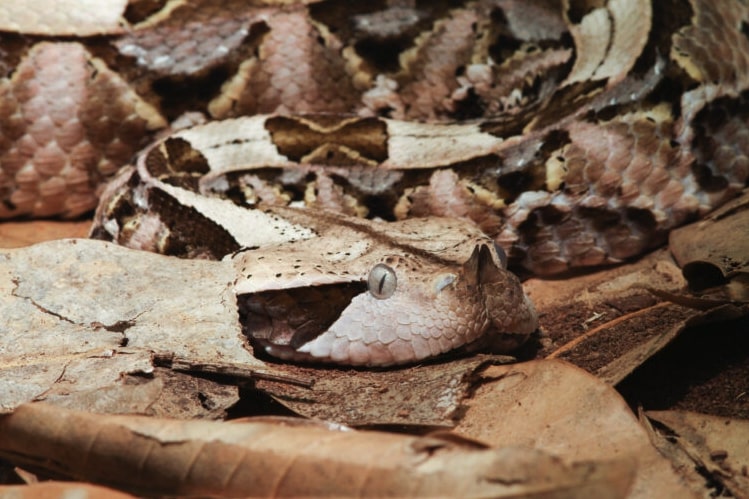The Gaboon Viper, also known as the Gaboon Adder, is one of Africa’s biggest and deadliest vipers. This elusive snake is known for its vivid and detailed camouflage, making it a genuine master of disguise. It is native to the lush rainforests and arid savannas of Central and West Africa.
Only very large King Cobras, which can grow to be 6 feet long and weigh more than 20 pounds, outweigh the snakes.
What’s more terrifying is that this snake has fangs that are the longest among all poisonous serpents, reaching up to 2 inches in length. The Gaboon Viper has one of the most effective venom delivery systems in the snake world.
Its venom, a strong combination of enzymes and toxins, has the ability to cause serious tissue damage, intense pain, and, if left untreated, may be deadly.
The serpent’s head is huge and triangular, but it’s the exquisite skin patterns that capture the imagination. The snake’s remarkable camouflage allows it to mix perfectly with the leaf litter on the forest floor, making it almost hard to see before it attacks.
The Gaboon Viper ambushes its victim in a careful and planned manner – it is a highly patient species that spends lengthy periods immobile before the assault. Eating fully grown bunnies, monkeys, even the rare little royal antelope. This ravenous predator demonstrates both its tremendous hunger and its ability to swallow large prey.
Luckily, this species’ human contacts and snakebites are uncommon. Because of its choice for distant settings and typically non-aggressive behaviour, recorded occurrences of human assaults are rare. When such events take place, they are often the consequence of unintended contacts in which people unwittingly walk on the snake.
If anti-venom is not provided in these terrible instances, the effects might be lethal. Notably, this snake has the capacity to hang onto its victim after biting, enabling it to inject higher amounts of venom into the circulation.
As previously stated, the Gaboon viper is exclusively found in Africa. Nevertheless, some Americans continue to keep them as pets in their homes.
My Gaboon Viper having a stroll about my house 🙂
by u/GaboonViperKeeper in nope
The Gaboon viper attracts snake lovers who want to keep one as a pet due to its reputation as the world’s biggest viper and its remarkable look. However, occasionally this option might have devastating effects, as was the case in Virginia in 2022.
A guy who was keeping the venomous snake as a pet was bitten, according to reports. Police were summoned, and the guy was rushed to Richmond Hospital and admitted to the emergency department in a race against time to save his life.
The problem was compounded by the fact that the VCU Medical Centre had run out of anti-venom supplied by the Smithsonian National Zoo. However, the Virginia Aquarium and Marine Science Centre in Virginia Beach made a great contribution of 35 vials of anti-venom to aid in the treatment.
It looks that 2022 was a bad year for Gaboon owners, since there were reports of a Gaboon Viper biting a man in North Carolina only a few months before the Virginia event. The guy needed 44 anti-venom vials and regrettably lost three fingers in the process.
Although there have been accounts of Gaboon Vipers escaping into the wild, the probability of seeing this deadly snake in the United States is exceedingly rare. The Georgia Department of Natural Resources reported a probable sighting of the lethal snake near Milledgeville, Georgia, in 2015.
A video uploaded by The Reptile Report became popular on social media in 2021. It showed a Gaboon Viper that had been discovered on the street, and people were intrigued by its outstanding camouflage against the surroundings. And when it moved, it resembled a caterpillar!
Gaboon Viper SlithersLook at this adorable little Gaboon viper out for a stroll! Video by @GhostPenguin. TRR is made possible by RodentPro.com
Posted by The Reptile Report on Tuesday, 1 June 2021
The video received a lot of attention, and it’s simple to understand why: what an amazing creature this is.
The Gaboon Viper is a tribute to nature’s miracles, demonstrating its incredible capacity to adapt, endure, and prosper in African rainforests.





